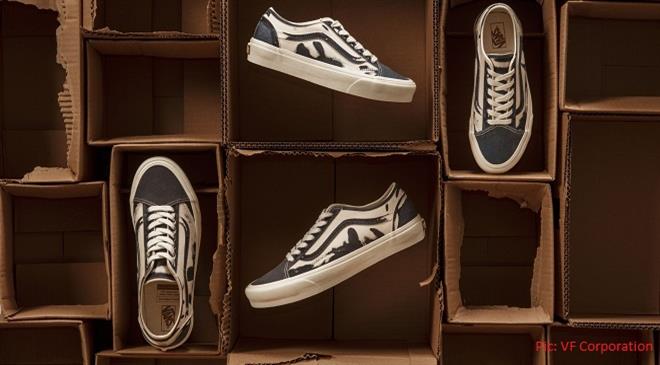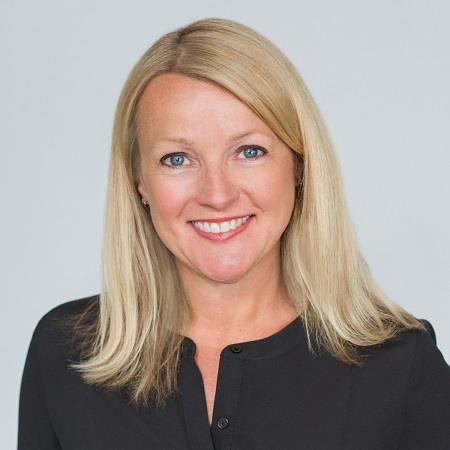VF has evolved to become a sustainability leader in the apparel industry
VF Corporation is one of the world’s largest apparel, footwear and accessories companies connecting people to the lifestyles, activities and experiences they cherish most through a family of iconic outdoor, active and workwear brands. VF’s VP Global Sustainability Jeannie Renné-Malone talks to Fibre2Fashion about the company’s sustainability strategy and goals.
In 2020, VF became the first company in the apparel and footwear industry to issue a ‘green bond’. What exactly is a green bond? Who can invest and where is the fund used?
That’s right—our €500 million green bond offering was an apparel and footwear industry first and we hope it inspires more. A green bond is similar to a traditional corporate bond—a type of debt security that is issued by a company and sold to investors—however designed specifically to support specific climate-related or environmental projects.
Our inaugural issuance garnered interest from a diverse group of investors around the world, many of whom have their own sustainability goals, objectives and strategies.
Green bonds are a win-win for the issuers and the investors. The overwhelming interest in our green bond serves as an endorsement from the business community for our purpose-led agenda and focus on connecting business success with actions that improve lives and our planet.
We have fully allocated the net proceeds to support projects that align with key UN Sustainable Development Goals, and support three key sustainability areas that are core to our business and our roadmap to meeting our SBTs: sustainable products and materials; sustainable operations and supply chain; and natural carbon sinks, including reforestation conservation projects and investments in regenerative agriculture practices.
Why is ‘Sustainability’ important for the apparel and footwear industry?
Similar to other industries, the apparel and footwear industry has a significant environmental footprint, which comes with a responsibility to prioritise environmental and social sustainability. VF’s commitment to sustainability is integrated throughout our business, and even in our purpose statement, “We power movements of sustainable and active lifestyles for the betterment of people and our planet.”
We know that consumers today are far more conscious of the products they buy and the companies they support. Similarly, investors, shareholders, analysts and regulators are increasingly concerned about the environmental and social risks of public companies.
We are happy to see many apparel makers responding, knowing that making fashion more sustainable is a major opportunity to make a positive impact. Many companies, including VF, are transitioning from the traditional, linear, unsustainable ‘take, make and waste’ business model to sustainable or circular design. At VF, we are designing products to be made from recycled materials with fewer virgin raw materials, to last longer, to be recyclable, to be disassembled and down-cycled at end-of-life, and some to be refurbished for resale. Increasingly, companies are assessing the end of life of products, exploring how products can be dismantled and recreated into new products to buy or rent.
At VF, we believe a true sustainability strategy doesn’t stop with sustainability and circularity. Instead, VF takes a holistic approach to also consider the impact on the people and communities where VF sources and operates around the world and determining how to best make a positive impact.
Since our founding in 1899, VF has evolved to become a sustainability leader in the apparel industry. We put ‘purpose’ on par with ‘profit’, taking both of these factors into account as we make decisions to grow and operate our business.
Our comprehensive Made to Change sustainability strategy reflects this approach, with bold commitments focusing on people, planet and products. While we are already making significant progress, we know we all have much more to do.

VF has made a commitment to source 100 per cent of its top nine materials from regenerative, recyclable or renewable sources by 2030. Which are these nine materials? From where do you plan to source them by 2030?
Like many in the apparel industry, raw material extraction, processing and production account for the largest portion of our carbon emissions globally, with our top materials accounting for 90 per cent of our raw material-related emissions. Thus, our sustainable materials vision as outlined above is a key focus of our sustainability strategy and an important lever to achieve our science-based targets.
Our top nine materials can change from year to year or as our portfolio of brands change. That said, priority materials (in no particular order) include cotton, leather, rubber, wool, polyester and nylon. These materials make up over 90 per cent of our material usage.
As we continue to invest in strategies to work towards our sustainable materials vision, VF and our brands are, for example, piloting regenerative agriculture principles around the world. We currently have pilots for leather, cotton, rubber, sugarcane and wool in countries including the US, India, Haiti, New Zealand and Thailand. We are excited to assess the positive social and environmental benefits from these regenerative agriculture projects and scale the most successful pilots to create a long-term supply of sustainable raw materials.
Traceability is a key component of our work to help us deeply understand our extended supply chain. As of last year, we have published traceability maps for 100 of our brands’ most iconic products. Moving forward, we have committed to fully trace five key materials (cotton, leather, rubber, wool and synthetics, which includes polyester and nylon) from Tier 1 to Tier 5 by 2027.
Beyond our sustainable materials vision, we are working towards our goal that by 2025 all cotton we source will be grown in the US, Australia or under a third-party cotton-growing sustainability scheme. We also aim for 50 per cent of our polyester to come from recycled materials by 2025.
What is VF’s ‘Made for Change’ strategy? What are the targets that the company wants to achieve?
Made for Change is our sustainability vision in action. It outlines and details our aspirations, programmes and plans for advancing environmental and social improvements across our business, portfolio of brands, global supply chain and communities worldwide.
Chief among our goals and targets include our science-based targets in which we aim to reduce our Scope 1 & 2 emissions 55 per cent by 2030, and our Scope 3 emissions 30 per cent by 2030 from a 2017 baseline; sourcing 100 per cent renewable energy for our owned and operated facilities by 2025; maintaining zero waste distributions centres; and to measurably improve the lives of one million garment industry workers and local community members by 2025.
As I noted earlier, Made for Change focuses on three key areas: product, planet and people.
On product, we know that traditional linear production is inherently inefficient and wasteful. Our strategy for creating better products centres on Circular, or Sustainable Design, Recommerce, and Rental. In apparel, these business models are already proving to be successful.
To illustrate, we’ve now trained all our product designers and business executives in circular economy principles, and we’re investing in educating the next generation of fashion designers to innovate for a more sustainable future in mind.
On planet, traditional thinking says the bigger the business, the greater its negative impact. We believe we create more shared value for our stakeholders by using our global scale as a force for good in the world and the planet.
For instance, we’re working to decarbonise our value chain in line with climate science guidance. As I mentioned, we’re also working to dramatically reduce the impact of our key materials so we can continue making high-performance apparel and footwear in a resource-constrained future. As of 2020, we’ve transitioned to 28 per cent renewable energy for our owned and operated facilities, a 17 per cent improvement since fiscal 2017.
As for people, we directly employ nearly 35,000 team members. Upwards of one million people from nearly 60 countries earn their income making our products. We have a responsibility to protect and uplift those who across our operations and supply chain.
How? We are striving to ensure diverse candidates comprise half of all people being considered when hiring and promoting associates. We are working to protect and lift up those who work across our supply chain by launching industry-leading initiatives aimed at empowering both workers and their communities to lead better lives because of their connection to our company. We break down silos with a holistic strategy to enable positive outcomes throughout our supply chain.
Our goal is to improve the lives of one million workers by 2025 and two million by 2030. Our industry-leading Worker and Community Development programme focuses on access to water and sanitation, adequate health and nutrition, affordable child-care and education, with a gender lens applied to each pillar. Since calendar 2017, we have reached more than 290,000 workers in nine countries. Finally, our goal is to amass one million associate volunteer hours by 2025.
Any more plans at VF on the ‘Sustainability’ front this year?
We continue to evolve and expand our sustainability commitments; therefore, it is fair to assume we will continue to evolve our strategies and initiatives. It is especially important today given the evolving science and the increasingly urgent scientific warnings about our planet, such as in the recent UN climate change report. In addition, we are witnessing a heightened focus on ESG disclosure, which will accelerate focus on transparency and accountability across our industry. As we drive to fulfil the ambitious sustainability commitments and targets we have set, we are always aspiring to work with our brands, industry and beyond to do more and do better for both people and the planet.
What are ‘natural carbon sinks’, and how is VF contributing to create such sinks?
Natural carbon sinks are nature-based climate solutions that pull carbon from the atmosphere—soil, agriculture, forests, the seas. Our science-based targets (SBTs) include an absolute reduction of Scope 1 and 2 emissions 55 per cent by 2030, and an absolute reduction of Scope 3 emissions 30 per cent by 2030, from a 2017 baseline. Protecting and investing in natural carbon sinks is an important part of the roadmap to meet our goals.
Our green bond framework specifically outlines use of proceeds eligibility for natural carbon sinks, including reforestation conservation projects, and investments in regenerative agriculture practices.
More broadly, our Sustainable Materials Vision outlines our intent to source our top nine materials from regenerative, responsibly-sourced renewable or recycled materials by 2030. We define regenerative as a variety of environmentally and socially conscious practices which aim to help promote biodiversity, enhance water cycles, improve soil health and sequester carbon. We see this as a space where there is still a lot to learn but has huge potential to make a positive impact.
Can you list VF’s science-based carbon emissions targets?
Our approved science-based targets include an absolute reduction of Scope 1 and 2 greenhouse gas emissions 55 per cent by 2030, from a 2017 baseline year, and an absolute reduction of Scope 3 greenhouse gas emissions 30 per cent by 2030 from that same baseline, focusing on farm-to-retail materials, sourcing operations and logistics.
We have also committed to using 100 per cent renewable energy at all owned and operated facilities worldwide by 2025. We are helping our third-party suppliers reduce their own emissions, and we are making changes in how we source materials and manufacture products to consistently become more energy efficient.
Today, 100 per cent of our in-scope distribution centres around the world are verified zero waste facilities, which also contributes to our emission reductions. As of 2020, VF transitioned to 29 per cent renewable energy usage in owned and operated facilities, a 17 per cent improvement since FY 2017.


